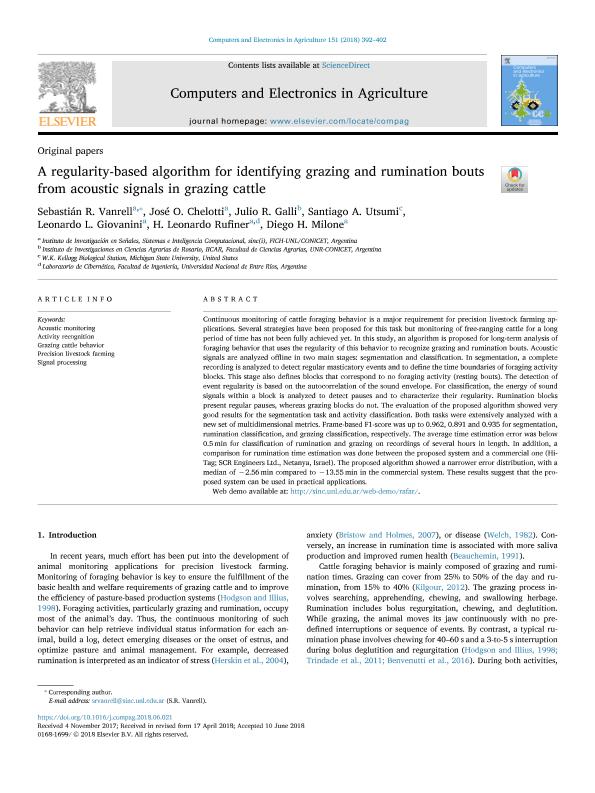Mostrar el registro sencillo del ítem
dc.contributor.author
Vanrell, Sebastián Rodrigo

dc.contributor.author
Chelotti, Jose Omar

dc.contributor.author
Galli, Julio Ricardo

dc.contributor.author
Utsumi, Santiago A.
dc.contributor.author
Giovanini, Leonardo Luis

dc.contributor.author
Rufiner, Hugo Leonardo

dc.contributor.author
Milone, Diego Humberto

dc.date.available
2019-10-23T19:49:46Z
dc.date.issued
2018-08
dc.identifier.citation
Vanrell, Sebastián Rodrigo; Chelotti, Jose Omar; Galli, Julio Ricardo; Utsumi, Santiago A.; Giovanini, Leonardo Luis; et al.; A regularity-based algorithm for identifying grazing and rumination bouts from acoustic signals in grazing cattle; Elsevier; Computers and Eletronics in Agriculture; 151; 8-2018; 392-402
dc.identifier.issn
0168-1699
dc.identifier.uri
http://hdl.handle.net/11336/87155
dc.description.abstract
Continuous monitoring of cattle foraging behavior is a major requirement for precision livestock farming applications. Several strategies have been proposed for this task but monitoring of free-ranging cattle for a long period of time has not been fully achieved yet. In this study, an algorithm is proposed for long-term analysis of foraging behavior that uses the regularity of this behavior to recognize grazing and rumination bouts. Acoustic signals are analyzed offline in two main stages: segmentation and classification. In segmentation, a complete recording is analyzed to detect regular masticatory events and to define the time boundaries of foraging activity blocks. This stage also defines blocks that correspond to no foraging activity (resting bouts). The detection of event regularity is based on the autocorrelation of the sound envelope. For classification, the energy of sound signals within a block is analyzed to detect pauses and to characterize their regularity. Rumination blocks present regular pauses, whereas grazing blocks do not. The evaluation of the proposed algorithm showed very good results for the segmentation task and activity classification. Both tasks were extensively analyzed with a new set of multidimensional metrics. Frame-based F1-score was up to 0.962, 0.891 and 0.935 for segmentation, rumination classification, and grazing classification, respectively. The average time estimation error was below 0.5 min for classification of rumination and grazing on recordings of several hours in length. In addition, a comparison for rumination time estimation was done between the proposed system and a commercial one (Hi-Tag; SCR Engineers Ltd., Netanya, Israel). The proposed algorithm showed a narrower error distribution, with a median of −2.56 min compared to −13.55 min in the commercial system. These results suggest that the proposed system can be used in practical applications.
dc.format
application/pdf
dc.language.iso
eng
dc.publisher
Elsevier

dc.rights
info:eu-repo/semantics/openAccess
dc.rights.uri
https://creativecommons.org/licenses/by-nc-sa/2.5/ar/
dc.subject
ACOUSTIC MONITORING
dc.subject
ACTIVITY RECOGNITION
dc.subject
GRAZING CATTLE BEHAVIOR
dc.subject
PRECISION LIVESTOCK FARMING
dc.subject
SIGNAL PROCESSING
dc.subject.classification
Ciencias de la Información y Bioinformática

dc.subject.classification
Ciencias de la Computación e Información

dc.subject.classification
CIENCIAS NATURALES Y EXACTAS

dc.title
A regularity-based algorithm for identifying grazing and rumination bouts from acoustic signals in grazing cattle
dc.type
info:eu-repo/semantics/article
dc.type
info:ar-repo/semantics/artículo
dc.type
info:eu-repo/semantics/publishedVersion
dc.date.updated
2019-10-22T17:46:08Z
dc.journal.volume
151
dc.journal.pagination
392-402
dc.journal.pais
Países Bajos

dc.journal.ciudad
Amsterdam
dc.description.fil
Fil: Vanrell, Sebastián Rodrigo. Consejo Nacional de Investigaciones Científicas y Técnicas. Centro Científico Tecnológico Conicet - Santa Fe. Instituto de Investigación en Señales, Sistemas e Inteligencia Computacional. Universidad Nacional del Litoral. Facultad de Ingeniería y Ciencias Hídricas. Instituto de Investigación en Señales, Sistemas e Inteligencia Computacional; Argentina
dc.description.fil
Fil: Chelotti, Jose Omar. Consejo Nacional de Investigaciones Científicas y Técnicas. Centro Científico Tecnológico Conicet - Santa Fe. Instituto de Investigación en Señales, Sistemas e Inteligencia Computacional. Universidad Nacional del Litoral. Facultad de Ingeniería y Ciencias Hídricas. Instituto de Investigación en Señales, Sistemas e Inteligencia Computacional; Argentina
dc.description.fil
Fil: Galli, Julio Ricardo. Universidad Nacional de Rosario; Argentina
dc.description.fil
Fil: Utsumi, Santiago A.. Michigan State University; Estados Unidos
dc.description.fil
Fil: Giovanini, Leonardo Luis. Consejo Nacional de Investigaciones Científicas y Técnicas. Centro Científico Tecnológico Conicet - Santa Fe. Instituto de Investigación en Señales, Sistemas e Inteligencia Computacional. Universidad Nacional del Litoral. Facultad de Ingeniería y Ciencias Hídricas. Instituto de Investigación en Señales, Sistemas e Inteligencia Computacional; Argentina
dc.description.fil
Fil: Rufiner, Hugo Leonardo. Consejo Nacional de Investigaciones Científicas y Técnicas. Centro Científico Tecnológico Conicet - Santa Fe. Instituto de Investigación en Señales, Sistemas e Inteligencia Computacional. Universidad Nacional del Litoral. Facultad de Ingeniería y Ciencias Hídricas. Instituto de Investigación en Señales, Sistemas e Inteligencia Computacional; Argentina
dc.description.fil
Fil: Milone, Diego Humberto. Consejo Nacional de Investigaciones Científicas y Técnicas. Centro Científico Tecnológico Conicet - Santa Fe. Instituto de Investigación en Señales, Sistemas e Inteligencia Computacional. Universidad Nacional del Litoral. Facultad de Ingeniería y Ciencias Hídricas. Instituto de Investigación en Señales, Sistemas e Inteligencia Computacional; Argentina
dc.journal.title
Computers and Eletronics in Agriculture

dc.relation.alternativeid
info:eu-repo/semantics/altIdentifier/url/https://linkinghub.elsevier.com/retrieve/pii/S0168169917313431
dc.relation.alternativeid
info:eu-repo/semantics/altIdentifier/doi/http://dx.doi.org/10.1016/j.compag.2018.06.021
Archivos asociados
